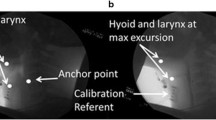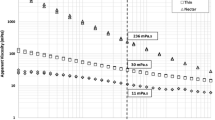Abstract
The purpose of this study was to assess displacement of oropharyngeal structures, particularly the hyoid bone and velum, and variations in timing of the pharyngeal stage of swallowing in the upright versus the supine position. Twelve Caucasian adult subjects between 19 and 27 years of age participated. Subjects were recorded swallowing 7 cc of liquid barium in the upright and supine positions. The hyoid bone had a significantly greater amount of anterior displacement while in the supine position compared to that of the upright position (p < 0.01). While in the upright position, the velum comes to a fully elevated position at nearly the same time as the initiation of the pharyngeal swallow (within an average of 27 ms of each other), whereas in the supine position the velum continues to elevate on average 115 ms after the initiation of the pharyngeal swallow. Results indicated a significant difference (p < 0.05) in the amount of velar movement from rest to the fully elevated position between the upright and supine positions for female subjects. The results from the study demonstrate variations in hyoid displacement, velar movement, and bolus movement through the pharynx with respect to the two body positions and the subjects’ gender.


Similar content being viewed by others
References
Kahrilas PJ, Dodds WJ, Hogan WJ. The effect of peristaltic dysfunction on esophageal volume clearance. Gastroenterology. 1988;94:73–80.
McConnel F. Analysis of pressure generation and bolus transit during pharyngeal swallow. Laryngoscope. 1988;98:71–8.
Palmer JB, Tanaka E, Ensrud E. Motions of the posterior pharyngeal wall in human swallowing: a quantitative videofluorographic study. Arch Phys Med Rehabil. 2000;81(11):1520–6.
Barkmeier JM, Bielamowicz S, Takeda N, Ludlow CL. Laryngeal activity during upright vs. supine swallowing. J. Appl Physiol. 2002;93(2):740–5.
Johnsson F, Shaw D, Gabb M, Dent J, Cook I. Influence of gravity and body position on normal oropharyngeal swallowing. Am J Physiol. 1995;269(5):G653-8.
Palmer B. Bolus aggregation in the oropharynx does not depend on gravity. Arch Phys Med Rehabil. 1998;79:691–6.
Dejaeger E, Pelemans W, Ponette E, Vantrappen G. Effect of body position on deglutition. Dig Dis Sci. 1994;39(4):762–5.
Inagaki D, Miyaoka Y, Ashida I, Ueda K, Yamada Y. Influences of body posture on duration of oral swallowing in normal young adults. J Oral Rehabil. 2007;34(6):414–21.
Inagaki D, Miyaoka Y, Ashida I, Yamada Y. Influence of food properties and body position on swallowing-related muscle activity amplitude. J Oral Rehabil. 2009;36:176–83.
Cardova-Fraga T, Sosa M, Wiechers C, De la Roca-Chiapas JM, Moreles AM, Bernal-Alvarado J, Huerta-Franco R. Effects of anatomical position of esophageal transit time: a biomagnetic diagnostic technique. World J Gastroenterol. 2008;14(37):5707–11.
Logemann J, Kahrilas P, Kobara M, Vakil N. The benefit of head rotation on pharyngo-esophageal dysphagia. Arch Phys Med Rehabil. 1989;70:767–71.
Logemann J, Rademaker A, Pauloski B, Kahrilas P. Effects of postural change on aspiration in head and neck surgical patients. Otolaryngol Head Neck Surg. 1994;110:222–7.
Shanahan T, Logemann J, Rademaker A, Pauloski B, Kahrilas P. Chin-down posture effect on aspiration in dysphagic patients. Arch Phys Med Rehabil. 1993;74:736–9.
Welch M, Logemann J, Rademaker A, Kahrilas P. Changes in pharyngeal dimensions effected by chin tuck. Arch Phys Med Rehabil. 1993;74:178–81.
Showfety KJ, Vig PS, Matteson S. A simple method for taking natural-head-position cephalograms. Am J Orthod. 1983;83(6):495–500.
Mohammed AJ, Marshall I, Douglas N. Effect of posture on upper airway dimensions in normal human. Am J Respir Crit Care Med. 1994;149:145–8.
Sutthiprapaporn P, Tanimoto K, Ohtsuka M, Nagasaki T, Iida Y, Katsumata A. Positional changes of oropharyngeal structures due to gravity in upright and supine positions. Dentomaxillofac Radiol. 2008;37:130–6.
Yildirim N, Fitzpatrick MF, Whyte KF, Jalleh R, Wightman AJA, Douglas NJ. The effect of posture on upper airway dimensions in normal subjects and patients with the sleep anpnea/hypopnea syndrome. Am Rev Respir Dis. 1991;144:845–7.
Perry J. Variations in velopharyngeal structures between upright and supine positions using upright magnetic resonance imaging. Cleft Palate Craniofac J. 2011;48(2):123–33.
Smith AM, Battagel JM. Non-apneic snoring and the orthodontist: radiographic pharyngeal dimension changes with supine posture and mandibular protrusion. J Orthod. 2004;31(2):124–31.
Hairfield M, Warren D, Hinton V, Seaton D. Inspiratory and expiratory effects of nasal breathing. Cleft Palate J. 1987;24(3):183–9.
Cheng C, Peng C, Chiou H, Tsai C. Dentofacial morphology and tongue function during swallowing. Am J Orthod Dentofacial Orthop. 2002;122(5):491–9.
Cuozzo GS, Bowman DC. Hyoid positioning during deglutition following forced positioning of the tongue. Am J Orthod. 1975;5:564–70.
Fujiki T, Inoue M, Miyawaki S, Nagasaki T, Tanimoto K, Takano-Yamamoto T. Relationship between maxillofacial morphology and deglutitive tongue movement in patients with anterior open bite. Am J Orthod Dentofacial Orthop. 2004;125(2):160–7.
Mays KA, Palmer JB, Kuhlemeier KV. Influence of craniofacial morphology on hyoid movement: a preliminary correlational study. Dysphagia. 2009;24(1):71–6.
Honda Y, Hata N. Dynamic imaging of swallowing in a seated position using open-configuration MRI. J Magn Reson Imaging. 2007;26:172–6.
Anagnostara A, Stoeckli S, Weber OM, Kollias SS. Evaluation of the anatomical and functional properties of deglutition with various kinetic high-speech MRI sequences. J Magn Reson Imaging. 2001;14(2):194–9.
Breyer T, Echternach M, Arndt S, Richter B, Speck O, Schumacher M, Markl M. Dynamic magnetic resonance imaging of swallowing and laryngeal motion using parallel imaging at 3T. J Magn Reson Imaging. 2009;27(1):48–54.
Sutton BP, Conway C, Bae Y, Brinegar C, Liang ZP, Kuehn DP. Dynamic imaging of speech and swallowing with MRI. Conf Proc IEEE Eng Med Biol Soc. 2009;2009:6651–4.
Acknowledgments
We thank Rebecca Ray Ebert, MA, and Joseph Barkmeier, MD, for their involvement in recording the subjects’ swallowing activity.
Author information
Authors and Affiliations
Corresponding author
Rights and permissions
About this article
Cite this article
Perry, J.L., Bae, Y. & Kuehn, D.P. Effect of Posture on Deglutitive Biomechanics in Healthy Individuals. Dysphagia 27, 70–80 (2012). https://doi.org/10.1007/s00455-011-9340-6
Received:
Accepted:
Published:
Issue Date:
DOI: https://doi.org/10.1007/s00455-011-9340-6




